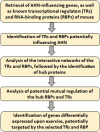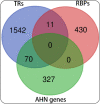Computational analysis of crosstalk between transcriptional regulators and RNA-binding proteins suggests mutual regulation of polycomb proteins and SRSF1 influencing adult hippocampal neurogenesis
- PMID: 37861946
- PMCID: PMC10501017
- DOI: 10.1007/s44192-023-00034-5
Computational analysis of crosstalk between transcriptional regulators and RNA-binding proteins suggests mutual regulation of polycomb proteins and SRSF1 influencing adult hippocampal neurogenesis
Abstract
Background: Adult hippocampal neurogenesis (AHN) is a clinically significant neural phenomenon. Understanding its molecular regulation would be important. In this regard, most studies have focused on transcriptional regulators (TRs), epigenetic modifiers, or non-coding RNAs. RNA-binding proteins (RBPs) have emerged as dominant molecular regulators. It would be significant to understand the potential cross-talk between RBPs and TRs, which could influence AHN.
Methods: The present study employed computational analyses to identify RBPs and TRs regulating AHN, followed by the analysis of their interaction networks and detection of hub proteins. Next, the potential mutual regulation of hub TRs and RBPs was analyzed. Additionally, hippocampal genes differentially expressed upon exercise were analyzed for potential regulation by the identified TRs and RBPs.
Results: 105 TRs and 26 RBPs were found to influence AHN, which could also form interactive networks. Polycomb complex proteins were among the TR network hubs, while HNRNP and SRSF family members were among the hub RBPs. Further, the polycomb complex proteins and SRSF1 could have a mutual regulatory relationship, suggesting a cross-talk between epigenetic/transcriptional and post-transcriptional regulatory pathways. A number of exercise-induced hippocampal genes were also found to be potential targets of the identified TRs and RBPs.
Conclusion: SRSF1 may influence post-transcriptional stability, localization, and alternative splicing patterns of polycomb complex transcripts, and the polycomb proteins may in turn epigenetically influence the SRSF1. Further experimental validation of these regulatory loops/networks could provide novel insights into the molecular regulation of AHN, and unravel new targets for disease-treatment.
Keywords: Adult hippocampal neurogenesis (AHN); Physical exercise; Polycomb complex; Post-transcriptional regulation; RNA-binding proteins (RBPs); SRSF.
© 2023. The Author(s).
Conflict of interest statement
The authors declare no competing interests.
Figures




Similar articles
-
Global Exploration of RNA-Binding Proteins in Exercise-Induced Adult Hippocampal Neurogenesis: A Transcriptome Meta-analysis and Computational Study.Biochem Genet. 2022 Dec;60(6):2471-2488. doi: 10.1007/s10528-022-10230-7. Epub 2022 May 11. Biochem Genet. 2022. PMID: 35546218
-
Transcriptome meta-analysis-based identification of hub transcription factors and RNA-binding proteins potentially orchestrating gene regulatory cascades and crosstalk in response to abiotic stresses in Arabidopsis thaliana.J Appl Genet. 2024 May;65(2):255-269. doi: 10.1007/s13353-024-00837-4. Epub 2024 Feb 10. J Appl Genet. 2024. PMID: 38337133 Review.
-
Role of SARS-CoV-2 in Altering the RNA-Binding Protein and miRNA-Directed Post-Transcriptional Regulatory Networks in Humans.Int J Mol Sci. 2020 Sep 25;21(19):7090. doi: 10.3390/ijms21197090. Int J Mol Sci. 2020. PMID: 32993015 Free PMC article.
-
Handshakes and Fights: The Regulatory Interplay of RNA-Binding Proteins.Front Mol Biosci. 2017 Sep 29;4:67. doi: 10.3389/fmolb.2017.00067. eCollection 2017. Front Mol Biosci. 2017. PMID: 29034245 Free PMC article. Review.
-
Role of SARS-CoV-2 in altering the RNA binding protein and miRNA directed post-transcriptional regulatory networks in humans.bioRxiv [Preprint]. 2020 Sep 22:2020.07.06.190348. doi: 10.1101/2020.07.06.190348. bioRxiv. 2020. Update in: Int J Mol Sci. 2020 Sep 25;21(19):E7090. doi: 10.3390/ijms21197090. PMID: 32676599 Free PMC article. Updated. Preprint.
References
Grants and funding
LinkOut - more resources
Full Text Sources

